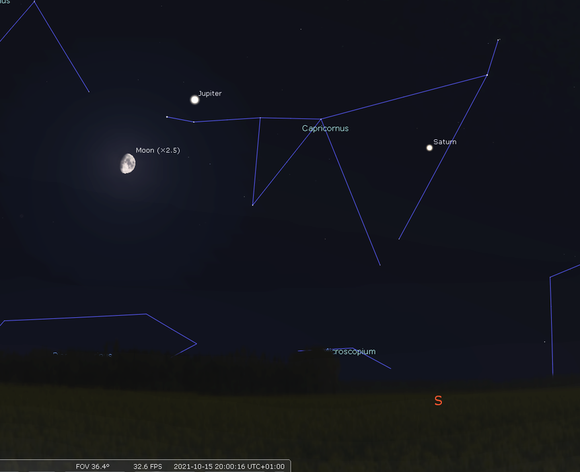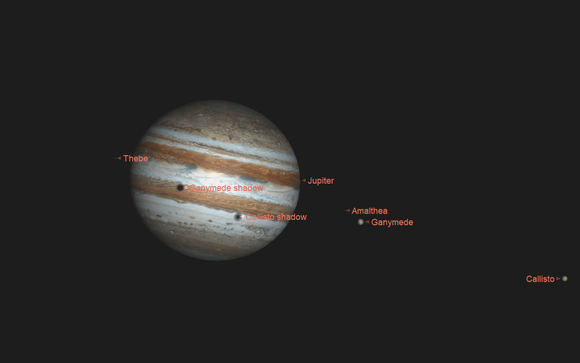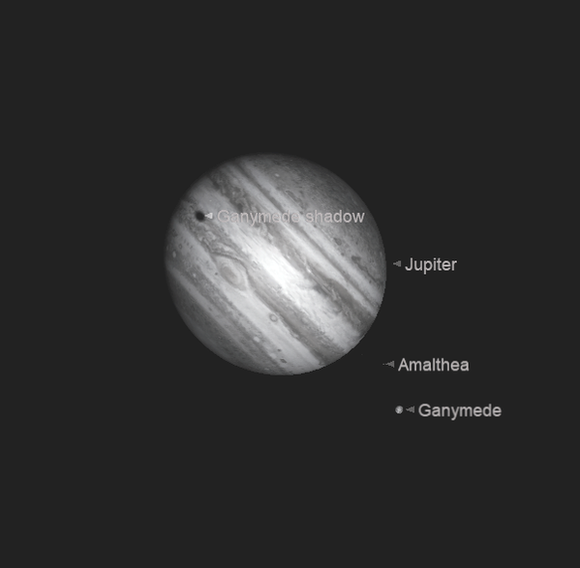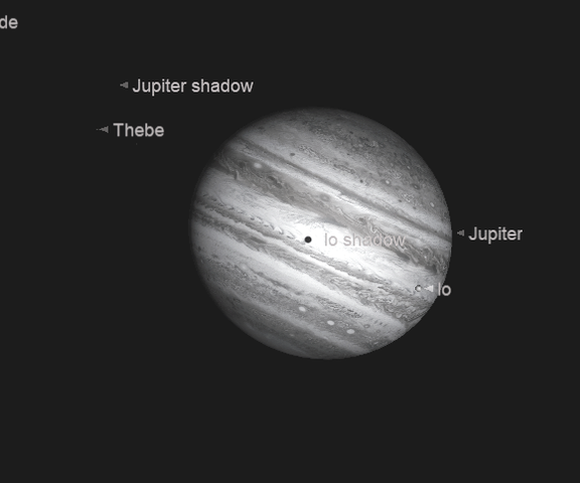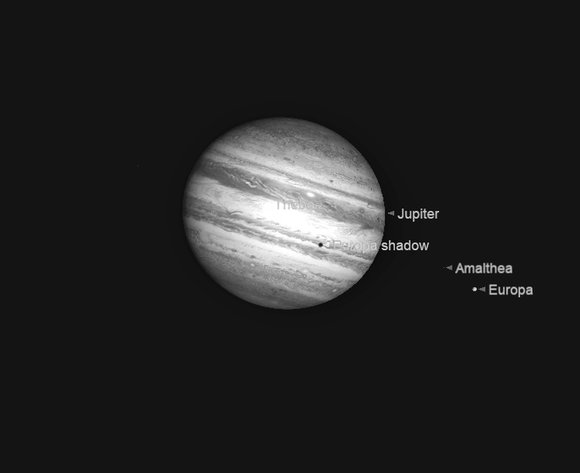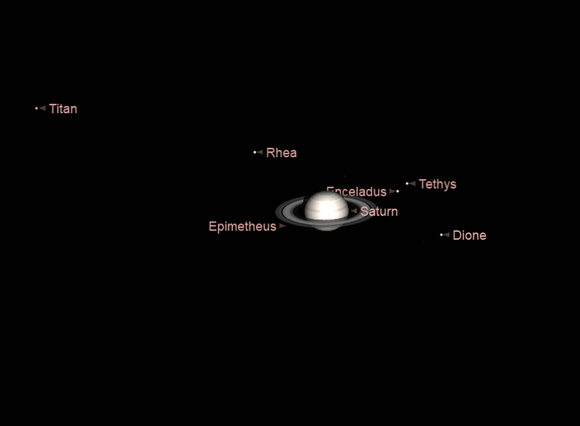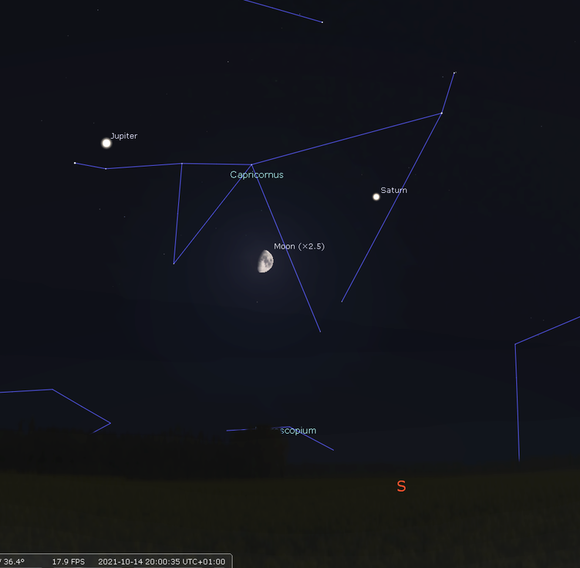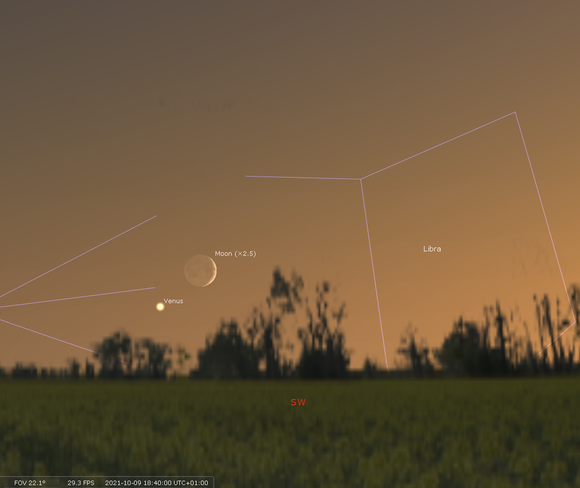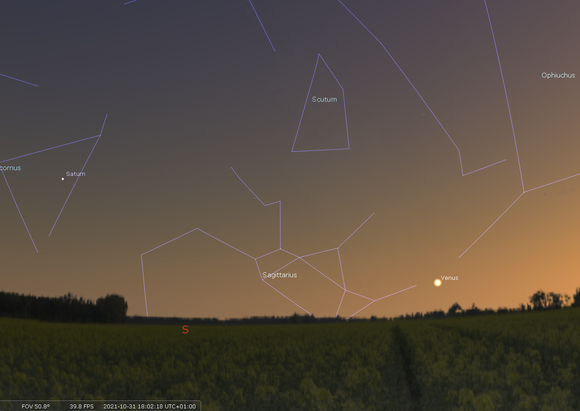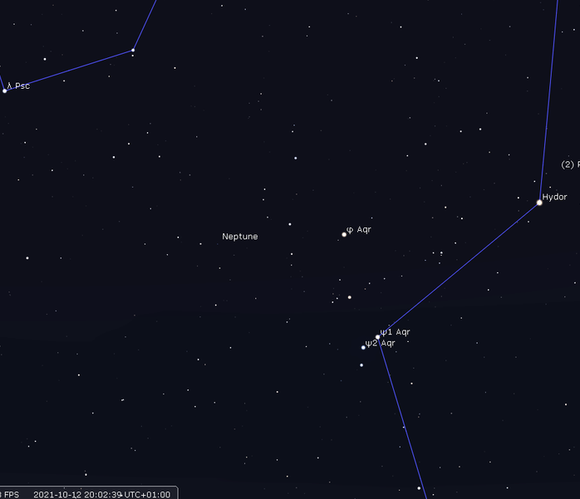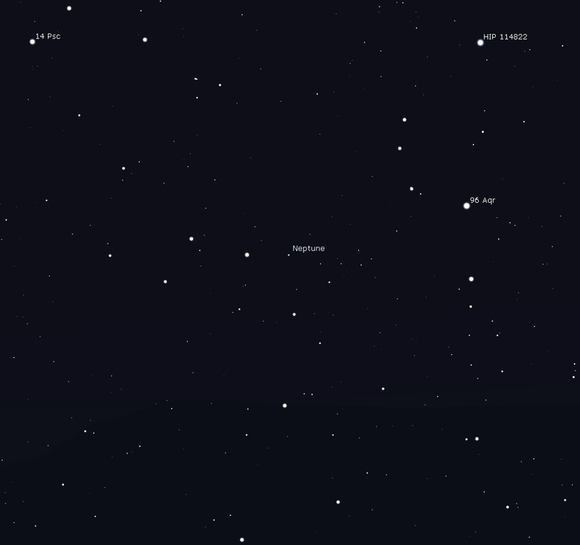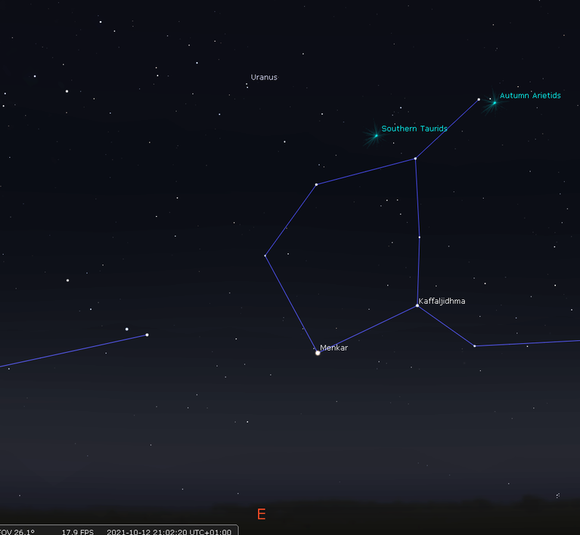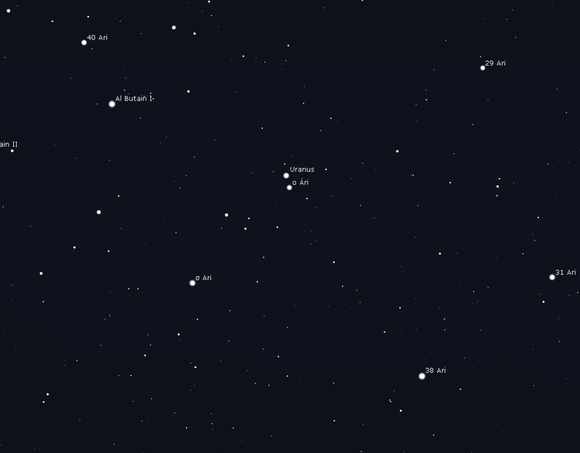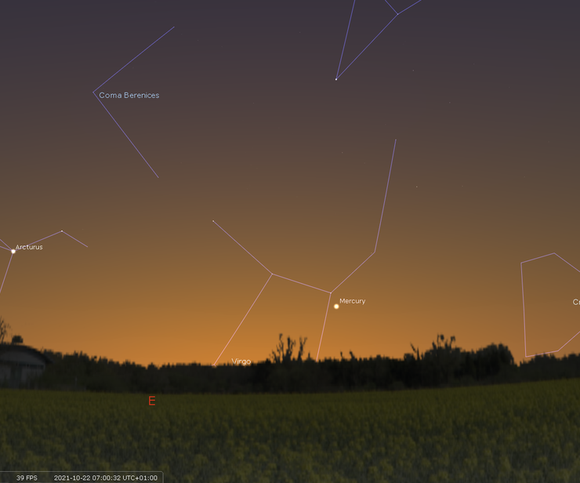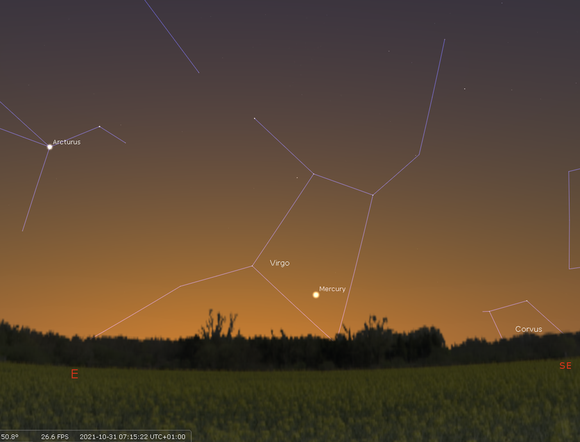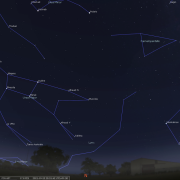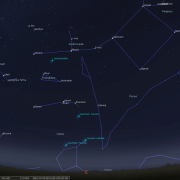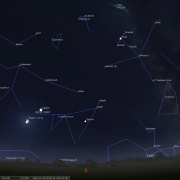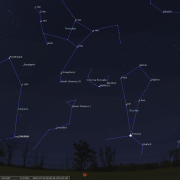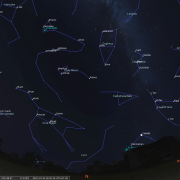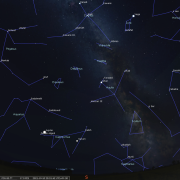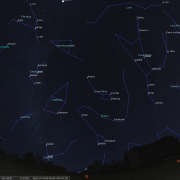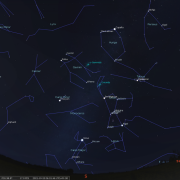In this month's Sky Notes:
Planetary Skylights - Brief
 At magnitude -2.6 Jupiter continues to be the most dominant planetary object in the night sky. At the start of October it is already visible in the SE as twilight falls culminating at a respectable 23 degrees altitude above the S horizon by 22:30hrs, allowing planetary observers a much greater observing window in which to study the largest planet in our solar system. Currently residing in western Capricornus, Jupiter becomes stationary amongst its faint stars on the 18th, before it resumes normal prograde motion (west to east) thereafter. By the end of October Jupiter will be apparent by 18:45hrs, culminating shortly after 20:00hrs. The Moon sits lower left of Jupiter on the 15th
At magnitude -2.6 Jupiter continues to be the most dominant planetary object in the night sky. At the start of October it is already visible in the SE as twilight falls culminating at a respectable 23 degrees altitude above the S horizon by 22:30hrs, allowing planetary observers a much greater observing window in which to study the largest planet in our solar system. Currently residing in western Capricornus, Jupiter becomes stationary amongst its faint stars on the 18th, before it resumes normal prograde motion (west to east) thereafter. By the end of October Jupiter will be apparent by 18:45hrs, culminating shortly after 20:00hrs. The Moon sits lower left of Jupiter on the 15th
As conspicuous as Jupiter is to the naked eye, through the eyepiece it is a wonderful sight to behold, a bright, noticeably oblate banded disk some 46 arc seconds in diameter, flanked by the Galilean moons' seen as specks of light close by. Even small telescopes will reveal some detail on the disk, whilst instruments of 6" (150mm) or larger will unveil considerably more. Look for the Great Red Spot (GRS) feature, an ever present storm which over the last decade has diminished in size and colour intensity. It may now be re-establishing itself. The GRS can be seen on Jupiter from 20:00hrs and before 23:00hrs on the following dates; October 2, 7, 9, 12, 14, 16, 17, 19, 21, 24, 26, 28 & 31.
Regular observers of the Jovian system will note the 'dance' of the Galilean moons around Jupiter, throwing up a different configuration each night. The four major moons are visible in 10x50 binoculars as specks of light, small scopes won't reveal a great deal more. If you have a 4" (100mm) aperture scope' and above, shadow transits of moons passing on the near side of Jupiter will be visible, jet black dots of varying size dependant on which moon is involved. The actual moons themselves are more difficult to spot as they pass in front of Jupiter, requiring much larger apertures. The most favourable shadow transits this month are on the following dates and times. Io - 6th @ 22:45hrs; 15th @ 22:00hrs, 22nd @ 21:00hrs & 29th @ 22:30hrs. Europa - 25th @ 20:00hrs. Ganymede and Callisto - 4th @ 20:30hrs. Finally Ganymede shadow and GRS Oct 12 @ 00:30hrs. By the end of October Jupiter is setting just after midnight.
 For UK observers Saturn is now ideally placed in the late evening sky above the southern horizon at a respectable height equating to 20 degrees. Residing a good hands span ahead of Jupiter amongst the stars of west Capricornus, Saturn appears quite conspicuous with an apparent magnitude of +0.5. The magnificent ring system is orientated with the North Pole tilted toward Earth by almost 17 degrees. This angle is slowly closing up with respect to Earth taking another 4 years before we arrive at the next ring plane crossing event. In the eyepiece Saturn remains a glorious sight and although Saturn is twice as far away as Jupiter, the disk size of 18.5 arc is very respectable, especially when you factor in the rings, the overall image size then compares favourably with Jupiter. The Moon lies between and below Saturn and Jupiter on the night of the 14th.
For UK observers Saturn is now ideally placed in the late evening sky above the southern horizon at a respectable height equating to 20 degrees. Residing a good hands span ahead of Jupiter amongst the stars of west Capricornus, Saturn appears quite conspicuous with an apparent magnitude of +0.5. The magnificent ring system is orientated with the North Pole tilted toward Earth by almost 17 degrees. This angle is slowly closing up with respect to Earth taking another 4 years before we arrive at the next ring plane crossing event. In the eyepiece Saturn remains a glorious sight and although Saturn is twice as far away as Jupiter, the disk size of 18.5 arc is very respectable, especially when you factor in the rings, the overall image size then compares favourably with Jupiter. The Moon lies between and below Saturn and Jupiter on the night of the 14th.
A scope with an aperture of 80-100mm (3.5-4") will reveal the two brightest rings; ring A (the outermost) and ring B. These are separated by the Cassini Division. Ring C lies closest to the disk and is more difficult to spot, especially when 'seeing' is unsteady, normally requiring scopes of 150mm (6"). Saturn has at least 60 moons most of which are very small, but you should at least spot Titan, its largest moon as a speck nearby. Titan is bright enough (mag+8.4) to be spied in binoculars and takes just under 16 days to orbit round Saturn. Scopes of 200mm + (8") will also reveal Rhea, Tethys and Dione as well as Iapetus. By the end of October Saturn is setting by 23:00hrs.
 If you have an unobstructed SW aspect, look for Venus low to the horizon around 30-40 minutes after sunset. At magnitude -3.6 Venus should be readily visible, but this brilliance is tempered by the low altitude and lighter sky conditions present. If possible view on the 9th between 18:15 and 18:30pm to spot a young crescent moon upper right of Venus. Throughout October careful observations of Venus approximately half an hour after sunset each day, will reveal that Venus is more or less ‘flat lining’ above the SW horizon. Given the low altitude, the image of Venus is naturally very poor in the eyepiece, even the phase is hard to distinguish; a waxing gibbous.
If you have an unobstructed SW aspect, look for Venus low to the horizon around 30-40 minutes after sunset. At magnitude -3.6 Venus should be readily visible, but this brilliance is tempered by the low altitude and lighter sky conditions present. If possible view on the 9th between 18:15 and 18:30pm to spot a young crescent moon upper right of Venus. Throughout October careful observations of Venus approximately half an hour after sunset each day, will reveal that Venus is more or less ‘flat lining’ above the SW horizon. Given the low altitude, the image of Venus is naturally very poor in the eyepiece, even the phase is hard to distinguish; a waxing gibbous.
 Neptune, the outermost planet, is now well placed for telescopic observations up in the SE evening sky. By the end of October it lies due south at 22:00hrs almost 32 degrees above the horizon. It is located midway between the faint loop of stars in Pisces marking one fish and Aquarius, the nearest naked eye visible star being phi Aqr at mag +4.2 located a few degrees to the west. Through binoculars the nearest 'conspicuous star' is 96 Aqr. Currently at a distance from Earth of approximately 2.7 billion miles (4.3 billion km), Neptune is not surprisingly tricky to track down and at magnitude +7.7 requires at least a decent pair of binoculars to spot it. In reality a telescope of 100mm aperture is required to make out the tiny blue/grey disk, which is less than 3 arc seconds across. See chart for location details.
Neptune, the outermost planet, is now well placed for telescopic observations up in the SE evening sky. By the end of October it lies due south at 22:00hrs almost 32 degrees above the horizon. It is located midway between the faint loop of stars in Pisces marking one fish and Aquarius, the nearest naked eye visible star being phi Aqr at mag +4.2 located a few degrees to the west. Through binoculars the nearest 'conspicuous star' is 96 Aqr. Currently at a distance from Earth of approximately 2.7 billion miles (4.3 billion km), Neptune is not surprisingly tricky to track down and at magnitude +7.7 requires at least a decent pair of binoculars to spot it. In reality a telescope of 100mm aperture is required to make out the tiny blue/grey disk, which is less than 3 arc seconds across. See chart for location details.
 Uranus is now more available for observation in the evening sky; albeit with a telescope. It is visible low in the east by 20:30hrs, but does not culminate due South until the early morning hours. It is located in the southern reaches of Aries, but is closer to the head of Cetus than the crooked line of stars marking Aries itself. At magnitude +5.7 it is brighter than Neptune and almost twice the angular diameter, but this is still very small. The most difficult aspect in spotting Uranus is actually indentifying the general area of sky it currently resides, this being in 'no man's land' and devoid of decent naked eye stars. Roughly speaking it lies 10 degrees below the chief star in Aries - Hamal. The nearest 'bright' apparent star through binoculars is omicron Ari at magnitude 5.7 which sits just below Uranus. Over the course of a month you will notice the movement of Uranus in comparison to this star. Technically speaking Uranus is actually visible to the naked eye, but transparent, very dark skies are required to achieve this. Through a telescope the very small disk of Uranus exhibits a ghoulish grey/green lustre.
Uranus is now more available for observation in the evening sky; albeit with a telescope. It is visible low in the east by 20:30hrs, but does not culminate due South until the early morning hours. It is located in the southern reaches of Aries, but is closer to the head of Cetus than the crooked line of stars marking Aries itself. At magnitude +5.7 it is brighter than Neptune and almost twice the angular diameter, but this is still very small. The most difficult aspect in spotting Uranus is actually indentifying the general area of sky it currently resides, this being in 'no man's land' and devoid of decent naked eye stars. Roughly speaking it lies 10 degrees below the chief star in Aries - Hamal. The nearest 'bright' apparent star through binoculars is omicron Ari at magnitude 5.7 which sits just below Uranus. Over the course of a month you will notice the movement of Uranus in comparison to this star. Technically speaking Uranus is actually visible to the naked eye, but transparent, very dark skies are required to achieve this. Through a telescope the very small disk of Uranus exhibits a ghoulish grey/green lustre.
Dawn Planets
 Mercury commences its most favourable morning apparition during the latter half of October, running into November. UK observers normally have just a few opportunities a year to catch elusive Mercury, either just after sunset of before sunrise. For this coming apparition Mercury will be apparent above the ESE horizon approximately 35-50 minutes before sunrise. Although notoriously elusive to spot, Mercury can appear surprisingly bright once tracked down, sometimes reaching mag -2, comparable with Jupiter and Mars. This apparition starts just after mid - October with Mercury rapidly climbing to an altitude of 10 degrees above the ESE horizon by the 25th. Initially, Mercury will not be too bright; (as is the case for all morning apparitions) appearing at mag +0.2. It will be at its brightest around the end of the month (mag -0.9), but will then be dropping back down to the horizon. Should you be able to target Mercury in the eyepiece its illumination grows from 30% to around 50% by the 25th. Do though be careful with timings, the cut-off point being 30mins before sunrise. Try spotting Mercury from the 22nd onwards from 07:00hrs BST, use binoculars initially, then once spotted, just the naked eye. Don't forget that the clocks go back one hour on the 31st. Good spotting.
Mercury commences its most favourable morning apparition during the latter half of October, running into November. UK observers normally have just a few opportunities a year to catch elusive Mercury, either just after sunset of before sunrise. For this coming apparition Mercury will be apparent above the ESE horizon approximately 35-50 minutes before sunrise. Although notoriously elusive to spot, Mercury can appear surprisingly bright once tracked down, sometimes reaching mag -2, comparable with Jupiter and Mars. This apparition starts just after mid - October with Mercury rapidly climbing to an altitude of 10 degrees above the ESE horizon by the 25th. Initially, Mercury will not be too bright; (as is the case for all morning apparitions) appearing at mag +0.2. It will be at its brightest around the end of the month (mag -0.9), but will then be dropping back down to the horizon. Should you be able to target Mercury in the eyepiece its illumination grows from 30% to around 50% by the 25th. Do though be careful with timings, the cut-off point being 30mins before sunrise. Try spotting Mercury from the 22nd onwards from 07:00hrs BST, use binoculars initially, then once spotted, just the naked eye. Don't forget that the clocks go back one hour on the 31st. Good spotting.

October sees meteor activity start to increase with three meteor showers having peaks during the month, so the chances of spotting a few shooting stars is quite reasonable. The Orionids (Oct 16- 27) are normally Octobers most prolific meteor shower, however this year's peak date over the night of Oct 21/22 coincides with an almost full Moon, the light from which will drown out many. Prospects are therefore not good. Peak rates in the early morning hours can yield up to 20 per hour, but only the brightest examples will cut through the moonlight glare, these will leave a persistent train. Along with the May Eta Aquarids, Orionids are associated with Comet Halley, but are more favourable for northern hemisphere observers due to the radiant being situated high in the S by early morning hours.
The Southern Taurids peak on the 10th, however rates will be little more than sporadic levels (5 per hour) but at least there will be no interference from the Moon.
The weak Piscid shower has three peak dates, Oct 13th normally the being the optimum one. Observed rates are little better than sporadic levels - around 3-7 per hour. Piscid meteors are often slow, of long duration, but not very brilliant. By midnight and into the early morning hours there will be very little moonlight to hamper viewing.
Perhaps the most interesting shower is the Giacobinids or Draconids (Oct 6 -10th peaking on the 8th) which are associated with the periodic comet Giacabini-Zinner (6yrs) The shower is very erratic, but can produce outbursts of activity. Observing over the night of the 8/9th, rates of around 10 per hour are possible in the early morning hours. There will be no Moon. The Draconids are associated with the constellation of Draco, which is located high up in the NW winding its way between the two celestial bears of Ursa Major and Minor.
October 2021 Sky Charts
Additional Image Credits:
- Planets and Comets where not otherwise mentioned: NASA
- Sky Charts: Stellarium Software and Starry Night Pro Plus 8
- Log in to post comments

